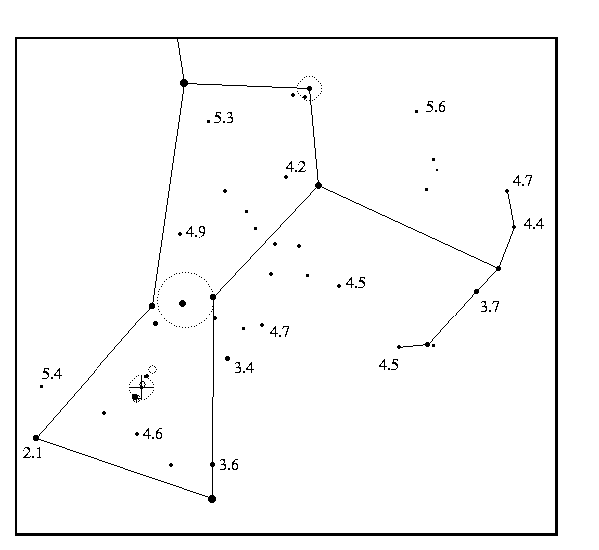
 Copyright © Michael Richmond.
This work is licensed under a Creative Commons License.
Copyright © Michael Richmond.
This work is licensed under a Creative Commons License.
How faint is the faintest star you can see?
Several factors affect your ability to see faint stars:
In order to see faint stars, you must allow your eyes to adapt to the dark. If you go outside at night (or sit in a dark room during the day), your eyes will slowly become more sensitive to faint objects. The process goes quickly at first (which is why you can walk into a dimly lit room from the outdoors on a sunny afternoon and yet still see well enough to avoid furniture), but slowly after the first few seconds. You eyes adjust to darkness by dilating their pupils: they may become about 7 millimeters wide, much larger than their normal size. It takes ten to twenty minutes for your pupils to open fully.
Question 1: Have a partner measure the width of your pupil inside a brightly lit room. Then go outside and wait for at least ten minutes. Then have your partner measure the width of your pupils again. What is the ratio of your eyes' light-collecting area in the dark, compared to in the light?
Any source of light close enough to strike your eyes directly will prevent your pupils from dilating. Make sure that you are shielded from nearby direct lighting.
Distant lights, from parking lots, airports, commercial buildings, etc., send large numbers of photons upwards into the sky. Some of those photons bounce off dust particles or air molecules, and head back down towards the ground. You can detect such distant sources of light as bright areas near the horizon. The closer and brighter the source, the farther up from the horizon the light pollution will spread.
Question 2: Look carefully around the horizon in every direction. Can you detect places where the sky is brighter than others? If so, describe the brightest spots, and the darkest spots. Give the direction of each.
If there are any clouds in the sky, they will appear as slightly brighter areas, due to the light from below which reflects off them.
Question 3: Are there any clouds in the sky? If so, estimate the fraction of the entire sky which they cover. Also, compare the brightness of a cloud (as close to the zenith as you can find) to the brightest area of light pollution (near the horizon).
Okay, you're ready to measure the limiting magnitude of the sky under the current conditions. Find the constellations Orion, Ursa Minor and Leo in the sky. Then use the charts below to determine the faintest star you can see in each constellation.
Question 4: What is the faintest star you can see in Orion? If you are working in a group, list the faintest star that each person can see.
Question 5: What is the faintest star you can see in the Little Dipper? If you are working in a group, list the faintest star that each person can see.
Question 6: What is the faintest star you can see in the head of Leo? If you are working in a group, list the faintest star that each person can see.
Now compare your results from the three constellations, and among all the members of your group.
Question 7: Did you find the same value for the limiting magnitude in each constellation? If not, can you explain why?
Question 8: Did each person in the group find the same value? If not, can you explain why?
Now, compare the limiting magnitude of your naked eyes versus that of your eyes assisted by binoculars. Take a pair of binoculars and observe carefully the area around the top of the "Question Mark" of Leo: in the area marked by a box in the Figure. Draw a picture showing all the stars you can see in this area. Make sure that you can identify the two brightest stars (mag 3.0 and 3.9), as well as the fainter one in between them (mag 5.3). Take your time; to do a good job may take 10 minutes or more. Look back and forth many times, from chart to sky, to make sure that you depict all the objects you can detect through binoculars.
Question 9: Use SkyMap Pro to identify the stars in your drawing. What was the limiting magnitude for observing through the binoculars?
Question 10: How much fainter are the faintest stars you can see through binoculars, compared to the faintest stars you can see with your naked eye? Calculate the ratio of intensities.
Question 11: What is the diameter of your dark-adapted pupil? What is the diameter of the binocular's lens? What is the ratio of collecting area? How does this ratio compare to the ratio of intensities of faintest object visible through each?
At the end of the session, ruin your dark adaptation by going into the Observatory House and standing in a lit room for a minute or two. Then go back outside and repeat your measurement of the faintest star you can see in each constellation. Try to finish your measurements within 3 or 4 minutes of leaving the House.
Question 12: How do your measurements of limiting magnitude with and without dark adaptation compare?
This page maintained by Michael Richmond. Last modified Mar 15, 1999.
 Copyright © Michael Richmond.
This work is licensed under a Creative Commons License.
Copyright © Michael Richmond.
This work is licensed under a Creative Commons License.